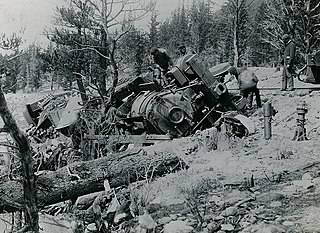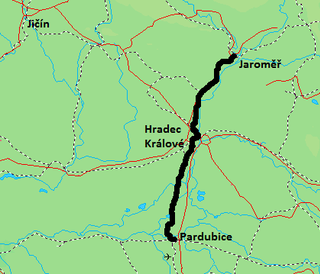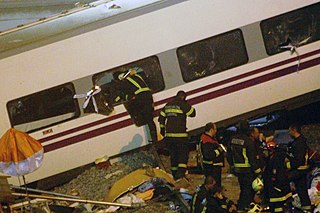Related Research Articles

In rail transport, a derailment occurs when a rail vehicle such as a train comes off its rails. Although many derailments are minor, all result in temporary disruption of the proper operation of the railway system and they are a potentially serious hazard.
The town of Morpeth in Northumberland, England, has what is reputed to be the tightest curve of any main railway line in Britain. The track turns approximately 98° from a northwesterly to an easterly direction immediately west of Morpeth Station on an otherwise fast section of the East Coast Main Line railway. This was a major factor in three serious derailments between 1969 and 1994. The curve has a permanent speed restriction of 50 miles per hour (80 km/h).

The Nuneaton rail crash occurred on 6 June 1975, on the West Coast Main Line just south of Nuneaton railway station in Warwickshire, England, United Kingdom.
The Sutton Coldfield train crash took place at about 16:13 on 23 January 1955 in Sutton Coldfield, Warwickshire, when an express passenger train traveling from York to Bristol, derailed due to excessive speed on a sharp curve.
The Federal Express was an overnight named passenger train run by the Pennsylvania Railroad and the New York, New Haven and Hartford Railroad between Washington, DC's Union Station and Boston, Massachusetts's South Station from 1912 to 1971. At different times, its route has taken it across the Hudson River via a car float between Port Morris and Jersey City, the Poughkeepsie Bridge, and finally the Pennsylvania Tunnel and Terminal Railroad. The final routing was identical to today's high-speed Northeast Corridor.

The Stéblová train disaster was a railway accident that occurred on 14 November 1960 at 17:42 CET on a single-track railway in Stéblová in Eastern Bohemia, Czechoslovakia. At 17:42 CET, a passenger steam train 608 traveling at a speed of 55 km/h collided with a diesel railcar 653 traveling at a speed of 60 km/h. 118 people died as a result of the accident and 110 were badly injured. It remains the deadliest accident in the history of Czech railway transport.

Over the latter years of the 19th and early years of the 20th centuries, Penistone in Yorkshire gained a name as an accident black-spot on Britain's railway network; indeed, it could be said to hold the title of the worst accident black-spot in the country. The main line through the town was the Woodhead route of the Manchester, Sheffield and Lincolnshire Railway between Sheffield Victoria and Manchester, London Road. The line was heavily graded with a summit some 400 yards inside the eastern portal of the Woodhead tunnel.
The Eltham Well Hall rail crash was an accident on the British railway system that occurred on 11 June 1972 at approximately 21:35. An excursion train from Margate to Kentish Town derailed on a sharp curve at Eltham Well Hall station, Eltham, London. The curve had a maximum permitted speed to be taken at 20 miles per hour (32 km/h) but the train was estimated to have been travelling at 65 miles per hour (105 km/h) resulting in the locomotive and all but one of the ten carriages derailing.
There have been a number of train accidents on the railway network of Victoria, Australia. Some of these are listed below.

The Grantham rail accident occurred on 19 September 1906. An evening Sleeping-Car and Mail train of the Great Northern Railway, running from London Kings Cross to Edinburgh Waverley hauled by Ivatt 'Atlantic' No 276 derailed, killing 14. The accident was never explained; the train ran through Grantham station, where it was scheduled to stop, and derailed on a set of points on a sharp curve at the end of the platform, which at the time had been set for a freight train. No reason was ever established as to why the train did not stop as scheduled, or obey the Caution and Danger signals.

The Cairns Tilt Train derailment occurred at 11:55 pm on 15 November 2004 when the City of Townsville diesel tilt train derailed north of Berajondo, approximately 342 km (213 mi) northwest of Brisbane, the state capital of Queensland, Australia.

The Knowle and Dorridge rail crash was a fatal rail crash that occurred at Dorridge railway station in the West Midlands, England, on 15 August 1963. Three people died in the crash after a signalman's error routed a small freight train into the path of an express passenger train which slowed but could not stop before colliding with it.

The Getå Railroad Disaster was a train disaster caused by a landslide in Getå, a town that is now part of the municipality of Norrköping on 1 October 1918. To date, it is the worst rail accident in Swedish history.

The Santiago de Compostela derailment occurred on 24 July 2013, when an Alvia high-speed train traveling from Madrid to Ferrol, in the north-west of Spain, derailed at high speed on a bend about 4 kilometres (2.5 mi) outside of the railway station at Santiago de Compostela. Of the 178 people injured, the provisional number of deaths in hospital had reached 79 by the following 28 July.

On the morning of December 1, 2013, a Metro-North Railroad Hudson Line passenger train derailed near the Spuyten Duyvil station in the New York City borough of the Bronx. Four of the 115 passengers were killed and another 61 injured; the accident caused $9 million worth of damage. It was the deadliest train accident within New York City since a 1991 subway derailment in Manhattan, and the first accident in Metro-North's history to result in passenger fatalities. The additional $60 million in legal claims paid out as of 2020 have also made it the costliest accident in Metro-North's history.
The 1953 New York Central Railroad accident occurred on the four-track mainline 2.4 miles east of Conneaut, Ohio at 10:02 P.M. on March 27, 1953. The accident sequence began when an improperly secured load of large pipes broke loose from a gondola car on an eastbound freight train. The loose pipe, dragged by the moving train, damaged the westbound passenger track. A passing westbound freight train crew notified the first train and stopped to assess what had happened. A fast westbound passenger train could not stop and derailed from the damaged track, colliding with the westbound freight on the adjacent track. Finally, an eastbound fast passenger train struck the derailed equipment from the first two trains. There were 21 deaths and 49 people were injured. This accident holds the record for the most trains involved in a single accident.
References
- Ministry of Transport; Col W P Reed (1962). Railway accident : report on the derailment that occurred on 3rd June 1962 at Lincoln in the Eastern Region of British Railways (PDF). HMSO.